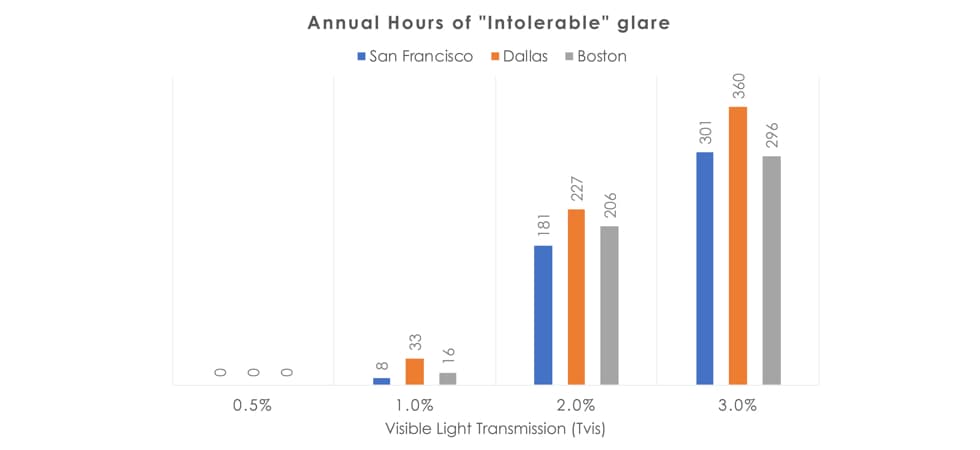
Smart glass glare control performance and durability: 2 sides of the same coin
Optimal glare control and visual comfort require 1% Tvis or lower that remains durable over time
At View, our vision is based around the science that natural light is required to live a healthy and productive life. For too long, people have been living indoors with problems like heat and glare while missing out on things our bodies and minds crave — natural light and beautiful views.
View is committed to delivering a smart window system that maintains visual comfort with optimal glare control in even the most challenging daylight conditions – for the life of your building. That’s why we offer smart windows that blocks over 99% of visible light under direct sunlight conditions.
When it comes to investing in smart windows, customers want peace of mind knowing they will provide complete glare control that lasts. Both the performance and durability of the product need to be evaluated to guarantee the right windows are chosen. While industry test methods, such as ASTM E 2141, help ensure smart glass meets basic performance levels, they do not certify it provides optimized visual comfort. Without durable visible light transmission, glass that meets ASTM E 2141 could begin testing at 1% Tvis and exit testing at 6% Tvis – well over the glare control threshold. On the other hand, a product might have great durability but will fail to provide optimal glare control and visual comfort because it cannot reach visual transmission levels below the 1% Tvis threshold for glare.
In this newly released white paper, the ability of View Dynamic Glass to maintain visual comfort in different climate zones with varying daylight conditions was explored. In addition, the study looked at the relationship between visible light transmission (Tvis) and visual comfort for different climates as well as the importance of achieving 0.5% to 1.0% visible light transmission to control direct sunlight. The results demonstrate the optimal Tvis level required to control glare and why simply meeting industry standards might not be enough.
The study
To demonstrate the sensitivity of visible light transmission and glare control, a daylight analysis was performed for a typical south-facing office building in three U.S. locations: Boston, MA, Dallas, TX, and San Francisco, CA. These locations were selected to represent a range of climates and latitudes. Four visible light transmission levels were studied (0.5%, 1.0%, 2%, and 3% Tvis), and annual glare analysis was performed for two desk locations behind the south facade. Daylight Glare Probability (DGP), a metric that quantifies discomfort due to glare, was calculated for each hour of the year for the two desk locations.

The results: 1.0% Tvis or lower required for complete glare control
The results of the study demonstrate that a 1.0% or lower visible light transmission is required to reduce or eliminate intolerable glare to acceptable levels. Climate, desk position, and visible light transmission of the glazing all play influential roles in determining glare mitigation and visual comfort in a workplace environment. However, the differences seen in climate and desk position are relatively minor compared to the differences in comfort due to visible light transmission. A 2% or higher visible light transmission produced an unacceptable frequency of intolerable glare for desk locations within 10 feet from the facade.
In our quest to improve occupant delight, View Dynamic Glass responds to all sources of glare using its dynamic tint states and predictive Intelligence control system. Even then, it is never advised to look directly at the sun, just the same as when wearing sunglasses outside or viewing a solar eclipse without special glasses.
Download the complete study here.
For more information on the requirements for lasting glare control and ASTM E 2141, download the eBook here.